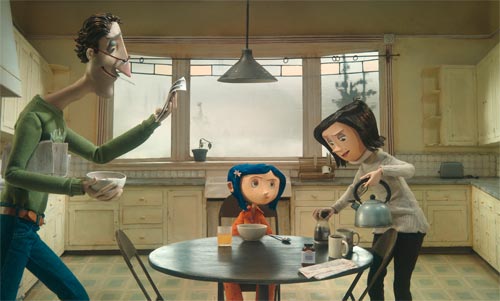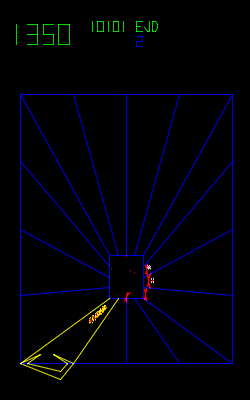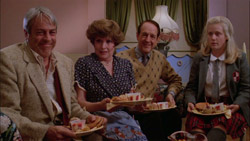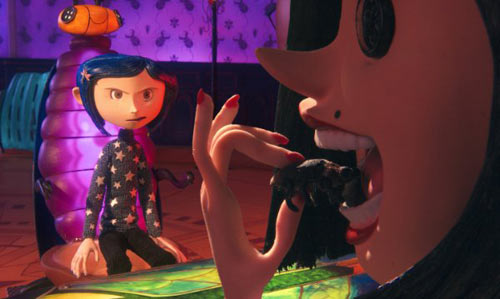
During the opening credits of Coraline, a thick sewing needle, manipulated by a vaguely sinister, vaguely mechanical praying mantis, pushed out of the screen at me as it zigged through the seams of stuffed dolls. Yes, I said, tapping the temple of my theater-issued, circularly polarized 3D glasses: these things are workin'.
But then a funny thing happened. Or didn't happen, actually. Once the mechanized seamstress passed the 3D test with flying colors, the movie rarely poked out at me again. Maybe the button-eyed character known as the Other Father reached his spring-loaded hands toward Coraline (and the camera, and me) a couple of times, but for the most part this is not the kind of 3D movie that tries to exceed the limits of the screen and get in your face. Instead, it does something I'd never seen before, something far more captivating: it maintains the consistent illusion that we're looking at a moving diorama just on the other side of the screen.
The in-your-face effects of many 3D films have a pretty narrow field of movement, approximately the size and shape of the old Tempest arcade game, a pyramid seen through the bottom whose edges will instantly jerk needles or fists or pistols back from your nose and flatten them into two dimensions whenever the hovering objects touch the illusion-destroying frame.


Instead of working to break out of the rectangle, artificially, Coraline establishes the frame as a window that looks into a three dimensional world, which frees the viewers' eyeballs to roam that space looking for details in the corners. Sometimes the screen is a window pane with raindrops running down its surface — between the audience and the moving figures — and sometimes the pane is lifted to give an unobstructed view. I suppose the roving camera and the edits themselves remind us that we're watching a movie, but within each shot it's easy enough to imagine that you're sticking your head into the box and moving it around, with the camera as your surrogate.
That world, by the way, is a dark and scary one that borrows a few ideas from Alice in Wonderland and Through the Looking Glass (and, I'm told, from MirrorMask, which is based on a book by the same author as Coraline, Neil Gaiman), but it finds horror on the other side rather than absurdity. Coraline is closer in spirit to that wonderful/terrible world in the Twilight Zone movie where the family is forced to watch cartoons and eat marshmallows around the clock, or else face the wrath of sweet, adorable Anthony. Here, understimulated, imaginative Coraline, left by her busy parents to explore her new house, opens a small plastered-over door that leads to an alternate universe. Everything is the same over there, but much better. Her parents are attentive, the food is delicious, the colors are warm and vibrant, and the neighbors are fabulous, bawdy entertainers. But the Other World has a dark side, too. For instance, you really shouldn't leave. And the Other Mother wants to eat the souls of children.

Coraline is a story of quiet voices, malicious undertones, and ominous, atmospheric music, and it's a story whose climax plays out like a video game, not in the sense that it devolves into a mindless chase but in the sense that Coraline determines the rules of the final quest through trial and error instead of the vague instructions given at the outset. I've found that while I in my thirties want to spend time with the instructions on the screen of an unfamiliar video game, a ten-year-old Player Two will tell me to "press A" — that is, skip the explanatory text — and while I'm hesitant, he'll feel comfortable plunging in and poking around. So does Coraline, who dives in head first but also accepts advice from a suave cat with a voice that sounds like velvet and Camels and an attitude that displays only mild curiosity about the strange ways of humans. But he offers tips that work to Coraline's advantage, and after some initial success at running the gauntlet, Coraline declares, "I'm starting to get the hang of this." And so she is.
The neighbors and the boy bicycler who live nearby are useful, too. They provide some assistance, but this is Coraline's problem to solve, and she is no princess.
It's safe to say that 3D won't save the movie theater. By most predictions, theatrical distribution will undergo major changes in the next few years as small films all but give up the hope of ever appearing on a screen taller than your living room. But the movie theater may save 3D, which is to say that if the rush to make everyone wear glasses actually results in an experience like Coraline more often than not, the assumption that 3D is a worn-out gimmick might seem old-fashioned.




Outstanding! My wife saw this film and completely agrees with your take. She thought the opening credits looked like they were coming close enough to almost poke someone with the needle. She said the story was great and I was delighted to find that the 3D stuff now doesn't have to kill the color of the film... the red and blue glasses from the 3D of my youth always seemed to kill the color and photography of a potentially decent film. Also, I like the idea that the film isn't just a gimmicky "see what we can do with 3D" type of film. It's nice to hear they're using the 3D to enhance the film, and not the film to show off the 3D.
Thanks for your review.
The 3-D films of the 1950 (especially 1953) did not use red & blue glasses. They used the same method as currently but the drawbacks of the earlier system have been marvelously overcome. No longer do we have two projectors interlocked projecting screen images. If one projector was slightly out-of-focus or not quite in register with the other (or off a frame or two), the results were eye fatigue in a major way. The new digital projectioning in perfect for the system and "Coraline" was certainly a state-of-the-art presentation of just how 3D could enhance the film viewing experience.
With this new improved system I wish that some of the better 3D films from the fifties (John Wayne's "Hondo", Alfred Hitchcock's "Dial M for Murder" and the musical "Kiss Me Kate", etc.) would be re-issued using the new system. It would be great to see these films projected properly.
Hunter, as I was watching Coraline I was thinking about how old this idea of 3D pictures really is. It's as simple as showing the left eye a slightly different picture from the right. The trick with cinema is to compress the two pictures needed for each frame onto one screen such that your eyes can break them apart again. And they've finally come up with a good way to do that.
That's a great idea to redo some of the good 3D films of the past. I saw Dial M for Murder in 3D several years ago and was surprised how enjoyable it was to see the gimmick applied to a movie that's actually pretty good for a change.
I finally caught up with Coraline this weekend and can heartily endorse both the movie and Rob's review. Great stuff, Rob. And Hunter's exactly right that the 3D really enhances the experience of watching Coraline. I suspect the movie would be much less interesting and enjoyable in 2D. I sorta hope they re-release Coraline somewhere down the road. I'd enjoy seeing it again, as long as I could do it in 3D.
I will take a little issue with Rob's disclaimer about children. I wouldn't take every child, for sure, but Coraline reminded me of the uncensored Grimm's Fairy Tales in its approach and tone. I think sometimes we shelter kids a bit too much, when sometimes all they want to do is be scared...as long as mom or dad is right next to them.
Of course, sometimes the child isn't the one who's scared. A fourth-grade boy I tutor was telling me how much he liked Coraline and then ended with this kicker: "My mom thought it was kinda creepy, but I don't know what she's talking about." :)
What disclaimer about children?
Ah, I had projected our discussion of this film, where you mentioned you didn't think it was appropriate for kids, into your review. Sorry about that.
Still, it allowed me to tell a story that amused me. And what better use can I think of for the Internet? :)
I personally wouldn't take kids under the age of six or seven to see Coraline. I wouldn't take 'em to The Uninvited, either, but the parents of the 3-5 year olds who were kicking my seat seem to disagree about that one.
But I agree with you that being scared by a movie can be fun. Nice story. :-)